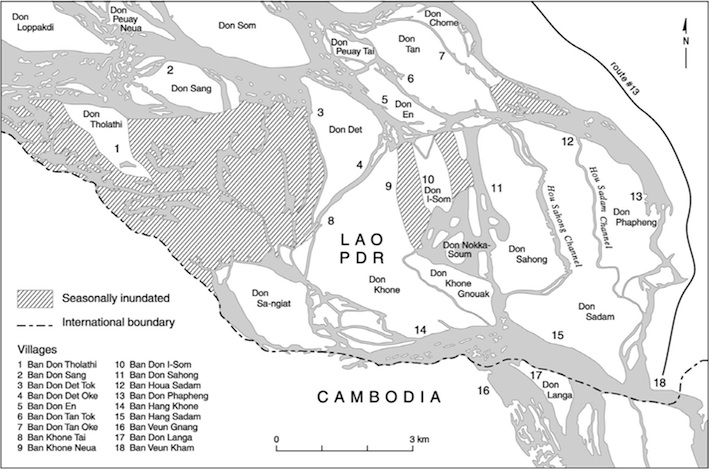My new article about the potential regional fisheries impacts and nutrition implications of constructing the Don Sahong Dam in the mainstream Mekong River in southern Laos has just been published in Critical Asian Studies (reference and abstract below).
There is now reason to believe that the Lao government is thinking about exporting much of the electricity from the Don Sahong Dam, if it were to be developed, to Cambodia, not Thailand as originally planned. There is, however, the problem of transmitting the electricity to Cambodia, as a new long transmission line would be required. The Malaysian investor, Mega First Corporation Berhad, would not want to pay for such an expensive transmission line, as it would compromise the economic viability of the project. There are rumours that the government of China may receive a request to support the construction of the transmission line, but it so far unclear if they would want to fund a project linked to such a potentially destructive project.
There would appear to be a viable and much less destructive option to the Don Sahong Dam. Compagnie Nationale du Rhone (CNR), a French company, is presently vying for approval to develop the Thakho Hydropower Project, which would not involve building a barrier across any of the channels of the mainstream Mekong River in the Khone Falls area of southern Laos. Instead, water would be diverted through a channel built around the Khone Phapheng Waterfall. The project would cause some negative local impacts to fisheries, but would not negatively impact on fish migrations, and thus would not cause problems at a regional scale. Only one of the two projects will proceed, as there is not enough water for the two projects. CNR has recently called for an independent assessment to compare the costs and benefits of the two projects. Their letter calling for such a study, and other research CNR has already done regarding the project, can be found here.
It will be interesting to see how hydropower development occurs, or do not occur, in the Khone Falls area of southern Laos.
_____________________________
Full reference:
Baird, Ian G. 2011. The Don Sahong Dam: Potential impacts on regional fish migrations, livelihoods, and human health. Critical Asian Studies 43(2): 211–235.
Abstract:
Plans are underway to construct twelve large hydropower projects on the un-dammed lower and middle mainstream Mekong River in Laos, Thailand, and Cambodia. One of the planned projects is a 30–32 meter–high hydroelectric dam with an expected 240 MW installed generating capacity to be built on the Hou Sahong Channel, less than one kilometer north of the Laos–Cambodia border, in the Khone Falls area of Khong District, Champasak Province, southern Laos. The project’s objective is to generate revenue by exporting electricity to Thailand or Cambodia. Concerns have been raised about the Don Sahong Dam(DSD), however. The main ones relate to potential repercussions on aquatic resources, and especially wild-capture fisheries dependent on migratory fish. This article examines the regional implications of the DSD, including possible impacts on food security, nutrition, and poverty alleviation. Fisheries losses in the Mekong Region from the DSD would negatively affect the nutrition of hundreds of thousands or even millions of people, especially in parts of Laos, Cambodia, and Thailand where nutritional standards are already low. Mekong fisheries are integral to food security in the region, and the DSD would make it difficult for governments, especially in Laos and Cambodia, to reach their health-related United Nations Millennium Development Goals and their objectives for reducing poverty.
Ian Baird is Assistant Professor of Geography at the University of Wisconsin, Madison. He worked on the fisheries component of the Thakho project EIA, although here he is representing only himself as an academic.
 Facebook
Facebook  Twitter
Twitter  Soundcloud
Soundcloud  Youtube
Youtube  Rss
Rss 